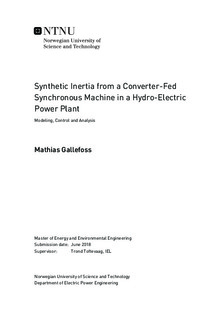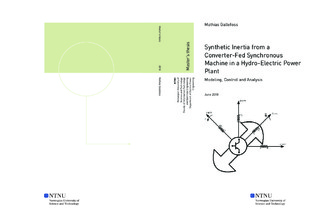| dc.description.abstract | As the share of variable renewable energy in the power system rises, the demand for balancing technologies to compensate for fluctuation in production increases. Pumped-storage hydropower has significant potential globally and is seen as the most mature storage technology available. Modern pump-storage plants utilize a power electronic interface between the machine and power system to control power consumption in pump mode. Introducing power electronic converters between the machine and grid causes the rotating mass of the machine to be independent of the frequency in the power grid. Therefore, the machine loses its ability to contribute to the inertia in the power system. To solve this, the converters can be controlled such that the effect of inertia is synthesized, often termed synthetic inertia.
A number of methods to emulate inertia exist, with a broad span in complexity and design. The most straightforward solutions release stored kinetic energy based on the frequency derivative or deviation. Other more complex solutions mimic the behavior of a synchronous machine, often referred to as virtual synchronous machine (VSM). The VSM method enables the converter to operate as a grid-connected synchronous machine with a speed governor and excitation system.
In this thesis two methods are developed; classical torque control with supplementary inertia controllers and virtual synchronous machine control. The methods are tested in a simulation model consisting of a converter-fed hydro-electric power plant connected to a simplified grid. It is shown that both methods performed as intended, emulating the effect of inertia during a power imbalance event. The classical torque control and VSM control improve the frequency nadir by 36.4% and 54.5% respectively based on the steady-state frequency for a given test case. The VSM method is found superior in the context of inertia support due to fast power control. Also, the VSM inherits a number of other advantages such as the possibility for dynamic inertia support. Dynamic inertia support allows the VSM to change the amount of synthetic inertia in the grid during operation, which can improve small-signal stability. | |

